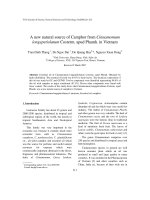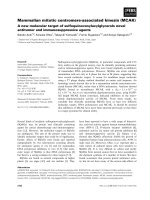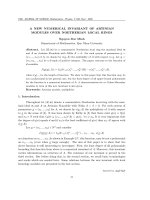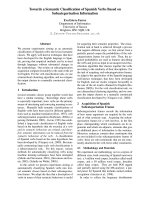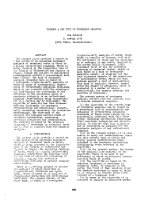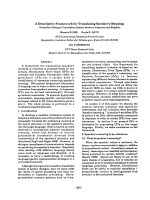Five Year Strategic Plan (2011-2016) - Towards a New Dawn Ministry of Women and Child Development Government of India potx
Bạn đang xem bản rút gọn của tài liệu. Xem và tải ngay bản đầy đủ của tài liệu tại đây (1.35 MB, 223 trang )
1
Five Year Strategic Plan
(2011-2016)
Towards a New Dawn
Ministry of Women and Child Development
Government of India
2
TABLE OF CONTENTS
Abbreviations 05
Executive Summary 08
Introduction 17
Methodology and Timeframe 20
Section 1: Ministry‟s Aspiration: Vision, Mission, Objectives and Functions 26
Section 2: Assessment of the Situation 34
o 2A: External Factors that Impact Us 34
o 2B: Stakeholder Analysis 35
o 2C: Strengths and Weaknesses of the Ministry 39
o 2D: Learning Agenda 53
Section 3: Outline of Strategy 54
o 3A: Potential Strategies 54
a. National Policy for Children 54
b. National Plan of Action for Children 57
c. Child Development 58
3
d. Early Childhood Care and Education (ECCE) 71
e. Child Protection 74
f. Child Participation 83
g. Child Budgeting 85
h. Crèche Scheme 88
i. Priorities for Women 92
j. Gender Budgeting 107
k. Trafficking 108
l. Nutrition Policy, Advocacy, Coordination and Strategy 111
m. Media and Communication 131
n. Advocacy 132
o. Autonomous Organizations 133
o 3B: Stakeholder Engagement Plan 144
o 3C: Building Knowledge and Capabilities 145
a. Research and Data Collection 145
b. Training and Capacity Building 151
4
o 3D: Assigning Weights to Priorities 153
Section 4: Implementation Plan 155
Section 5: Linkage between Strategic Plan and RFD 213
Section 6: Cross Departmental and Cross Functional Issues 213
o 6A: Linkage with Potential Challenges Likely to be Addressed in the 12
th
Plan 213
o 6B: Identification and Management of Cross Departmental Issues Including
Resource Allocation and Capacity Building Issues 216
o 6C: Cross Functional Linkages within Departments/Offices 221
o 6D: Organizational Review and Role of Agencies and Wider Public
Service 221
Section 7: Monitoring and Reviewing Arrangements 223
5
ABBREVIATIONS
ANM Auxiliary Nurse Midwife
ASHA Accredited Social Health Activist
AWCs Anganwadi Centres
AWW Anganwadi Worker
AWH Anganwadi Helper
BDO Block Development Officer
CARA Central Adoption Resource Agency
CBGA Centre for Budget and Governance Accountability
CBO Community Based Organisation
CD Child Development
CEDAW Convention on the Elimination of all forms of Discrimination Against
Women
CMBS Conditional Maternity Benefit Scheme
CMO Chief Medical Officer
CPCR Commissions for Protection of Child Rights
CPI Consumer Price Index
CSR Centre for Social Research
CSO Civil Society Organisations
CSWB Central Social Welfare Board
CWCs Child Welfare Committees
CW Child Welfare
DCPO District Child Protection Officer
DCPS District Child Protection Society
DHO District Health Officer
DLHS District Level Household Survey
ECCE Early Childhood Care and Education
EFA Education For All
FCI Food Corporation of India
FNB Food and Nutrition Board
FYSP Five Year Strategic Plan
6
HNI High Networth Individuals
ICMR Indian Council of Medical Research
ICT Information and Communication Technology
ICCW Indian Council for Child Welfare
ICDS Integrated Child Development Scheme
ICPS Integrated Child Protection Scheme
IGMSY Indira Gandhi Matritva Sahyog Yojana
IMNCI Integrated Management of Neonatal and Childhood Illness
IMR Infant Mortality Rate
INGO International Non Government Organisation
IPC Indian Penal Code
IYCF Infant and Young Child Feeding
JSY Janani Suraksha Yojana
JJB Juvenile Justice Board
MDGs Millennium Development Goals
MDM Mid Day Meal
MHFW Ministry of Health and Family Welfare
MIS Management Information System
MLTCs Middle Level Training Centres
MMR Maternal Mortality Rate
MTA Mid Term Appraisal
MWCD Ministry of Women and Child Development
NCAER National Council for Applied Economic Research
NCPCR National Commission for the Protection of Child Rights
NCW National Commission for Women
NFHS National Family Health Survey
NGO Non Government Organisation
NIN National Institute of Nutrition
NIPCCD National Institute for Public Cooperation and Child Development
NNMB National Nutrition Monitoring Board
NNP National Nutrition Policy
NPAC National Plan of Action for Children
NPAN National Plan of Action on Nutrition
7
NPC National Policy for Children
NRDWP National Rural Drinking Water Programme
NRHM National Rural Health Mission
PCPNDT Pre-Conception and Pre-Natal Diagnostic Techniques
PHC Primary Health Centres
PI Plan India
PIP Programme Implementation Plan
PMES Performance Monitoring and Evaluation System
PRIs Panchayati Raj Institutions
RCH Reproductive and Child Health
RFD Results Framework Document
RGI Registrar General of India
RGSEAG Rajiv Gandhi Scheme for Empowerment of Adolescent Girls
RMK Rashtriya Mahila Kosh
RTE Right to Education Act
SCPCR State Commission for Protection of Child Rights
SHC Sub Health Centre
SNP Supplementary Nutrition Programme
SRS Sample Registration System
SSA Sarva Shiksha Abhiyan
SWOT Strengths Weaknesses Opportunities and Threats
TFR Total Fertility Rate
TSC Total Sanitation Campaign
UNCRC United Nations Convention on the Rights of the Child
UNICEF United Nations Children‟s Fund
UT Union Territory
WHO World Health Organisation
8
EXECUTIVE SUMMARY
1.0 The Ministry of Women and Child Development has nodal responsibility to advance the
rights and concerns of women and children and promote their survival, protection,
development and participation in a holistic manner. The Ministry was constituted with the
prime intention of addressing gaps in State action for women and children and for
promoting inter-Ministerial and inter-sectoral convergence to create gender equitable and
child-centred policies, programmes, schemes and legislation.
1.1 In accordance with the requirements of the Performance Monitoring and Evaluation
System (PMES) of the Government of India, the Ministry is responsible for the
development of a Ministry-specific Results Framework Document (RFD), which sets out
the overall vision for the Ministry. Amongst the activities flowing from the RFD for 2010-11
is the development of an implementable Five-Year Strategic Plan (FYSP) for the period
between 2011 and 2016 - a process which will contribute to the development of India‟s
Twelfth Five-year Plan and coincide with the culmination of the Millennium Development
Goals (MDGs) target of 2015.
2.0 The preparation of the FYSP has been an exercise in refining the Ministry‟s vision,
mission, objectives and functions for the women and children of India; organising and
augmenting the internal capacities of the Ministry – by identifying knowledge gaps and
creating a learning agenda; forging strategic partnerships with external stakeholders
through periodic consultations; articulating priorities and formulating implementation
strategies to achieve short term targets and long term goals; and creating more effective
monitoring and evaluation mechanisms.
3.0 The Ministry‟s vision encapsulates its aspiration for the holistic development of women
and children belonging to all ages, castes, religions, language groups, communities, socio-
economic status and geographical locations. The Ministry aspires to promote the nurture,
care and protection of all children; provide them with a safe and secure environment
within which they can creatively develop their potential, enjoy their childhood and
adolescence and fearlessly voice their concerns. Ensuring the right of children to life and
9
survival (particularly focusing on the girl child); enhancing their physical, psychological
and cognitive development as well as emotional and social well being; and access to
nutrition, education, health care, shelter and justice are core concerns of the Ministry.
3.1 The Ministry aspires to provide women with a safe and protective environment,
focussing on the elimination of all forms of discrimination and violence against women
such as female foeticide, rape, dowry, sexual harassment, physical & psychological abuse
and domestic violence. The Ministry would like to strengthen the legislative backing
available to women and facilitate the speedy delivery of justice to them. Through more
inclusive programming and convergent action, MWCD would like to enhance women‟s
socio-economic status and increase their rights based awareness and decision-making
potential. The Ministry will also continue to advocate and work towards ensuring gender
parity in literacy rates and educational attainment; reducing the gender gap in workforce
participation; increasing the participation of women in local governance; significantly
stepping up the coverage of beneficiaries among women and girls; promoting women‟s
right to inheritance and direct ownership of property and land; and facilitating equal
access to and control over assets and resources. In doing so, the Ministry also aims to
address societal power dynamics and vested interests as well as bring about
transformation in patriarchal and feudal mindsets.
3.2 MWCD aspires to deliver the highest quality of services to both women and children;
set rigorous norms and standards for programme delivery; promote full budget utilization
of approved schemes on women and children and increase the budget allocation for
women within the Ministry‟s overall budget. The Ministry is committed to strengthening
the justice delivery mechanism to comprehensively address sexual abuse, trafficking and
violence against women and children. The FYSP aims to align the personnel, processes,
systems, programmes and institutions of the Ministry with a view to bridge the gap
between aspiration and current reality.
4.0 The social indices relating to women and children depict a dismal picture of their
current situation. Much needs to be done to combat the high rates of IMR, MMR, anaemia,
malnutrition and undernutrition as well as the high fertility rate in the country as a whole.
Furthermore, raising the child sex ratio for age group 0-6 years, reducing the gender gap
10
in literacy, increasing the overall literacy rate, reducing the school drop-out rate - all of
these present a huge challenge for the Government. Crimes against women and children
continue to show an upward trend, with rising figures for kidnapping, abduction, rape and
buying and selling of girls for prostitution. Trafficking of women and children for
exploitation and violence need to be tackled more vigorously. Achieving gender equity
through social, economic and political empowerment also requires innovative legislative
and policy interventions along with a strong implementation mandate. The Ministry will
continue to work towards achieving increased alignment and coordination amongst
policies, legislation and programmes of other line Ministries to tackle the above-mentioned
challenges.
5.0 The review of the National Policy for Children (1974) and the National Plan of Action
for Children (2005) are at the forefront of the Ministry‟s child-related priorities. The Policy
and Plan of Action need to be aligned with the current and projected needs of all children
(a child being all individuals below the age of 18 years) in India and with International
Conventions such as the UNCRC. The Ministry aims to develop a plan of action with better
resource allocation as well as achievable targets, measurable indicators and deadlines,
which corresponds with the changes being brought about in the National Policy for
Children (NPC). The National Coordination Group would be revived and activated to
ensure convergent and timely action to achieve the targets of the NPAC.
5.1 The Eleventh Five Year Plan and its Mid Term Appraisal along with various
consultations reflect the debate and the larger consensus on the Integrated Child
Development Scheme (ICDS) and its desired impact. The ICDS platform is viewed as a
base for providing a continuum of care in a life-cycle approach aimed towards impacting
holistic mother and child development. In order to achieve this, there is consensus on the
need to restructure and strengthen ICDS both programmatically and structurally, thereby
establishing and ensuring standards of quality, grass roots coverage as well as flexibility in
operations. The Ministry will facilitate the universalization as well as expansion of the third
phase of ICDS. It will also work towards renewing its focus on under– 3s; strengthening
the ICDS AWC platform; augmenting nutrition & health education; monitoring
supplementary nutrition; strengthening ICDS Management Information System (MIS) and
11
the use of ICT; conducting regular surveys and impact evaluation studies; and promoting
the increased participation of women and their communities.
5.2 Within the context of Early Childhood Care and Education (ECCE), preparing a National
ECCE Policy Framework along with the implementation plan, establishing a National Child
Development Resource Centre, developing a curriculum, activity booklet and PSE Kit as
well as quality capacity building and monitoring and evaluation measures will be a priority
for MWCD.
5.3 For the next five years, the Ministry will focus on promoting the improved
implementation of the JJ Act through allocation of funds under ICPS; enhanced monitoring
and evaluation mechanisms and increased coordination with State Governments
responsible for the implementation. The Act in its present form is limited in its coverage of
offences against children and structures and mechanisms are provided only for child
offenders. The JJ Act will be appropriately amended to expand the scope of the offences
covered and to create provisions for care and support services for child victims. MWCD will
advocate for the long term goal of child-centred jurisprudence with separate structures
and procedures for child victims and witnesses. In the interim, it advocates for the
development of child-sensitive systems, standards and procedures within the mainstream
criminal justice system itself. The „Protection of Children from Sexual Offences Bill‟ is a
step in this direction.
5.4 Having recently launched the Integrated Child Protection Scheme (ICPS) with the aim
to provide care, protection and a safe and secure environment for children in conflict with
the law as well as children in need of care and protection, the Ministry will focus on the
effective implementation and consolidation of the scheme. Its focus will be to promote
quality non-institutional care, professionalized institutional support, the expansion of
Childline and the development of a credible database on missing children and those in
difficult circumstances. During the next five years, MWCD will also augment its efforts
towards training and capacity building, monitoring and evaluation, research, advocacy and
coordination related to child protection. The Ministry will also advocate for the setting up
of SCPCRs and Children‟s Courts in all the states of the country.
12
5.5 The Ministry aims to promote child participation and provide all children with an
environment wherein they are aware of their rights and possess the freedom and
opportunity to fully and freely express themselves. It aims to create mechanisms to
incorporate children‟s views into mainstream policy-making and programme formulation
processes. During the next five years, MWCD will also pilot and institutionalise successful
models of child participation in accordance with its obligations under the UNCRC.
5.6 Child budgeting is a tool to examine a government‟s commitment to child welfare,
development and protection programmes for any given fiscal year and to assess if these
adequately reflect the rights and needs of children. MWCD will push for coordinated child
budgeting efforts to ensure allocation of resources for child related programmes and
schemes and to track their utilization.
5.7 The past few decades have shown a rapid increase in nuclear families and breaking up
of the joint family system. Thus the children of these women, who were earlier getting
support from relatives and friends while their mothers were at work, are now in need of
day care services which provide quality care and protection for the children. Although a
realistic estimate of the requirement of crèches was not possible, the Rajiv Gandhi
National Crèche Scheme for the Children of Working Mothers was launched on 1.1.2006.
Over the next five years, the Ministry will revamp the existing Scheme with well laid out
procedures and monitoring systems, and enhanced financial and staffing norms. After
upgradation and consolidation of the existing crèches, the Scheme will be expanded to
uncovered areas through a careful demand assessment in association with the State
Governments.
6.0 The National Policy for the Empowerment of Women (NPEW) was formulated with the
express goal of addressing discrimination against women, strengthening justice delivery
and legal mechanisms, providing better access to health care and other services, equal
opportunities for women‟s participation in decision-making and mainstreaming gender
concerns in the development process. The Ministry proposes to prepare a Plan of Action to
implement the NPEW. It also proposes a review of existing laws dealing with issues of
violence against women with a view to strengthen them. These include laws such as the
Protection of Women from Domestic Violence Act 2005 (PWDVA), the Dowry Prohibition
13
Act (DPA) and the Indecent Representation of Women (Prohibition) Act, 1986 (IRWA).
The Ministry will also be focusing on the enactment of new laws including the „Protection
of Women against Sexual Harassment at Workplace Bill, 2010.‟ The Ministry aims to
augment schemes addressing the issue of violence against women. The „Financial
Assistance and Support Services to Victims of Rape‟ Scheme is founded on the principle of
restorative justice and seeks to restore the affected woman to a position of dignity and
self-confidence. The Ministry will institute a universalised women‟s helpline and a one stop
crisis centre for women. In order to strengthen the implementation of these policies,
legislation and schemes, MWCD will ensure adequate financial and human resources as
well as the appropriate institutional and advocacy mechanisms at the State and district
levels.
6.1 In order to promote the socio-economic empowerment of women, MWCD proposes to
augment its existing schemes such as STEP, Swadhar, Working Women‟s Hostels Scheme,
Priyadarshini and Dhanalakshmi. The National Mission for the Empowerment of Women
has a strong component on economic and social interventions for the empowerment of
women through a coordinated approach with participating Ministries and State
Governments.
6.2 Trafficking of women and children violates the basic tenets of human rights including
the right to live with dignity and self-respect. It occurs for various purposes such as
labour, organ trade, and for commercial sexual exploitation. Factors like poverty,
vulnerability of women and children, little or no access to education and health care, and
lack of livelihood options are some of its underlying causes. MWCD has adopted a multi
pronged approach to prevent and combat trafficking. Ujjawala, a comprehensive Scheme
for Prevention of Trafficking and Rescue, Rehabilitation and Re-Integration of Victims of
Trafficking and Commercial Sexual Exploitation is being implemented since 2007. In the
next five years, the Ministry will focus on strengthening monitoring and evaluation and
addressing the gaps in existing interventions, strengthening prevention efforts, building
capacities of implementing agencies for orderly and humane rescue effort and effective
law enforcement and reforms. Another priority will be to enable rehabilitation and
reintegration of the victims of trafficking in society through quality rehabilitation services
and skill building.
14
7.0 The FYSP acknowledges the complexity and multi-dimensional causes of maternal and
child under-nutrition such as poverty, inadequate food consumption, inequitable food
distribution, improper maternal infant and child feeding and care practices, inequity and
gender imbalances and restricted access to quality health, education and social care
services. A number of other factors including economic, environmental, geographical,
agricultural, cultural, health and governance issues complement these general factors. In
accordance with the National Nutrition Policy (NNP) 1993 and the National Plan of Action
on Nutrition (NPAN) 1995, MWCD accords high priority to addressing under-nutrition
through multi sectoral interventions by different sectors. The Ministry aims to reduce
malnutrition among children (underweight prevalence) in the age group 0–3 years to half
its present level and reduce anaemia among women and girls. It will also strengthen the
role of the Food and Nutrition Board (FNB).
7.1 SABLA aims to improve the nutritional and health status of adolescent girls and equip
them with life skills and provide them with knowledge on family welfare, health and
hygiene, information and guidance on existing public services and mainstreaming them
into formal schooling. For the next five years, the Ministry will focus on SABLA‟s
implementation in 200 districts to begin with, followed by evaluation and further
expansion across the country.
7.2 The Indira Gandhi Matritva Sahyog Yojana aims to improve the health and nutrition
status of pregnant, lactating women and infants by the promotion of appropriate
practices, care and service utilisation during pregnancy, safe delivery and lactation
through conditional cash transfers. For the next five years, the Ministry will focus on
IGMSY‟s implementation in 52 districts to begin with, followed by evaluation and further
expansion across the country.
8.0 In the next five years, the Ministry will promote the strategic use of the mass media as
a resource to advance its vision for the development of women and children. It will focus
on developing mechanisms for scaling up the process of information dissemination on its
policies, legislation, schemes and programmes, thereby increasing their accessibility to
women and children in the country.
15
10.0 As a nodal Ministry for women and children, MWCD will strengthen its efforts to
promote increased convergence and coordination within different sectors to create a
consolidated impact on the lives of women and children. Platforms such as the National
Mission for the Empowerment of Women and the National Coordination Group will be used
to steer this process. The Ministry will also advocate actively within line Ministries and
other fora to secure the rights and benefits for women and children.
11.0 In order to bridge critical information gaps and facilitate policy, legislation and
programme formulation processes, the Ministry will commission qualitative & quantitative
research and impact evaluation studies and strive to create a credible and up-to-date
statistical database on women and children in the country.
12.0 The Ministry aims to institute new capacity building and training modules for
programmes and schemes relating to women and children in the next five years. Since
capacity building involves much more than training, the Ministry will also emphasize on
providing government officers and functionaries with the understanding, skills and access
to information & knowledge that would enable them to perform effectively and to promote
inter-sectoral coordination between different stakeholders.
13.0 MWCD has six autonomous bodies namely the National Commission for the
Protection of Child Rights (NCPCR), the National Institute for Public Cooperation and Child
Development (NIPCCD), Central Adoption Resource Agency (CARA), the Central Social
Welfare Board (CSWB), the National Commission for Women (NCW) and the Rashtriya
Mahila Kosh (RMK). It also has one attached office – the Food and Nutrition Board (FNB).
During the next five years, the Ministry aims to review and strengthen the overall
functioning of these institutions, augment relevant programmes, discard those which have
lost utility and introduce new ones in alignment with the efforts of the Ministry and in
accordance with the evolving concerns of women and children.
14.0 The Ministry has formulated a detailed strategic implementation plan. The
implementation matrix delineates the broad objectives, corresponding activities, verifiable
indicators and timelines for the completion of those activities. It also highlights the
16
projected outcomes as well as the assumptions and limitations of the whole exercise. The
corresponding financial plan for the implementation of activities is not provided for in the
FYSP. The financial requirements for the first year of the FYSP will be met according to the
annual allocations outlined in the Eleventh Five Year Plan. The resources for subsequent
years of the FYSP will be augmented through an alignment of FYSP targets with those of
the Twelfth Plan to ensure allocation of resources.
15.0 In order to assess the implementation of the FYSP strategies, the Ministry will
monitor and evaluate their progress through the annual RFDs and undertake periodic
course corrections as warranted. The Ministry‟s seven Independent Responsibility Centres
(IRCs) will also develop independent RFDs and synchronize these with the annual RFD and
the FYSP of the Ministry. The Citizen‟s/Clients Charter is another review mechanism aimed
at improving the Ministry‟s services for the wider public. The Ministry has also instituted a
Grievance Redress Mechanism for ensuring prompt and effective redressal of grievances
received. The Ministry‟s website now contains a link to the Centralised Public Grievance
Redress and Monitoring System (CPGRAMS) on its official homepage. The Independent
Responsibility Centres of the Ministry have also been linked to CPGRAMS.
17
INTRODUCTION
The Department of Women and Child Development (set up in 1985 as a part of the
Ministry of Human Resource Development) was upgraded into the Ministry of Women and
Child Development on 30.01.2006. This Ministry has been set up to function as the nodal
agency to advance the rights and concerns of women and children and promote their
survival, protection and development in a holistic manner. For discharging its functions,
the Ministry would be addressing gaps in State action for women and children and
promoting inter-Ministerial and inter-sectoral convergence to create gender equitable and
child-centred policies, programmes, schemes and legislation. The Ministry also aims to
increase the decision-making potential of women and encourage child participation in
matters concerning them.
In accordance with the requirements of the Performance Monitoring and Evaluation
System (PMES) of the Government of India, the Ministry is responsible for the
development of a Ministry-specific Results Framework Document (RFD), which sets out
the overall vision for the Ministry. Importantly, the RFD acts as an accountability
framework and a mechanism for the allocation of responsibilities. The RFD, which was
initially developed for the last quarter of 2009-10 and followed up for 2010-11, translates
the vision of this Ministry into a set of measurable goals, listing priorities, outlining
activities, setting up success indicators and establishing measurable targets for the
Ministry. Amongst the activities flowing from the RFD for 2010-11 is the development of
an implementable Five-Year Strategic Plan (FYSP) for the Ministry, covering the period
2011-2016. The major part of the Ministry‟s Strategic Plan period will coincide with the
country‟s Twelfth Five-Year Plan period (2012-2017) and is also expected to feed into the
process of development of the Twelfth Five-year Plan. The five year term of this plan will
coincide with the culmination of the Millennium Development Goals (MDGs) target of
2015. The creation of this plan has, therefore, been of crucial relevance for this Ministry.
This Five-Year Strategic Plan document for 2011-2016 has been formulated with an
understanding of the Ministry‟s specific mandate and nodal role for the development, care
and protection of women and children. This mandate primarily includes (a) formulation of
plans, policies and programmes for women and children; (b) enactment and amendment
18
of legislations related to them; and (c) overall guidance and coordination of the efforts of
governmental and non-governmental organisations working in the field of women and
child development. The Ministry‟s programmes and schemes play a supplementary and
complementary role to the other developmental programmes and processes related to
women and children in sectors like health, education, urban and rural development etc.
The formulation of this Five-Year Strategic Plan began with refining the Ministry‟s vision
and mission for women and children in India. The overall objective of the Strategic Plan
has been to formulate both short-term as well as long-term goals and objectives for the
development of women and children, to identify and set out the Ministry‟s core priorities
and strategies to achieve them and to institute measurable indicators to assess the
Ministry‟s progress in implementing its plans. This process complements the formulation of
the RFD, which seeks to address, through a set of measurable indicators, the Ministry‟s
core objectives, action plans and progress made on them on an annual basis.
The exercises conducted for the formulation of this Plan have been explained in the
methodology section. It is important to highlight that these exercises have been
conducted by the Ministry through internal and external consultations with its bureaus,
autonomous bodies, civil society organisations, independent experts, UN agencies as well
as other international development partners.
The Ministry believes that before ideating new schemes, programmes and legislations,
there is a need to focus on achieving pre-existing goals and objectives. The development
of mechanisms for monitoring and evaluation will be necessary to ensure effective
implementation and service delivery of existing schemes. For this, it will be important to
devise methods to measure both qualitative and quantitative outcomes. The indicators
chosen will have to be substantiated with empirical data, which in turn require better
quality data collection, research and capacity building. The Ministry is also conscious of
the need to take purposeful and decisive steps to bridge the gaps and shortfalls in
fulfillment of the Eleventh Plan agenda. The development of the Five-Year Strategic Plan
of the Ministry constitutes yet another concrete and measured step towards aligning the
people, processes, systems, programmes and institutions towards the fulfillment of the
19
commitments of the XI Plan and building on them to realize the Ministry‟s vision and
mission for women and children.
The Ministry hopes that the FYSP, coupled with the RFD, will act as a guide to improve its
strategic focus on women and children and will be adapted by related Ministries, the
Planning Commission and State Governments to suit their needs and concerns through a
coordinated programming process. The FYSP is then an exercise in organising and
augmenting internal capacities of the Ministry – by identifying knowledge gaps and
creating a learning agenda; forging strategic partnerships with external stakeholders;
articulating priorities and formulating strategies to achieve short term targets and long
term goals; creating more effective monitoring and evaluation mechanisms; and assessing
resource implications of the plan. In relation to the latter, a detailed financial plan for the
implementation of the activities envisaged is not included in the FYSP. The financial
requirements to implement the first year of the FYSP (2011-2012) would be made
available from the annual allocation of the Ministry in accordance with the budget for the
year 2011-2012 as per the agreed strategies and programmes in the Eleventh Five Year
Plan. The Ministry will advocate for integrating this FYSP in the Twelfth Five Year Plan of
the country so that the required financial resources for the implementation of the
proposed strategies would be available in the subsequent financial years.
Complemented with field-level and regional experiences, greater convergence and
effective collaboration with relevant partners, the FYSP has the potential of leading the
Ministry towards the achievement of its vision and mission for women and children.
20
METHODOLOGY AND TIMEFRAME
The Ministry of Women and Child Development initiated the Strategic Planning process by
putting together an Action Plan for the development of the FYSP document. This was to
ensure that the Strategic Plan for the Ministry is finalised by November 2010, with
implementation slated to begin in 2011. As part of the Strategic Planning process, the
Ministry has been engaged in a series of exercises designed by the Cabinet Secretariat.
These exercises aimed at facilitating the development of the FYSP document as an
implementable overall strategic to achieve the short-term and long-term goals of this
Ministry, linked to specific measurable milestones.
According to the Cabinet Secretariat guidelines, „a strategy is an integrated set of choices
to reach an objective.‟ The formulation of a strategy involves making choices based on a
„data-driven‟ assessment of the current situation. Within this line of thought, the Ministry
was required to choose certain paths of action over others based on a situational analysis
and, through an in-depth comparison of prospective plans or paths of action. This process
was then supposed to steer the resources deployed by the Ministry into the direction of
the chosen path. The exercises chosen for this purpose were to be completed by the
Ministry based on a series of internal and external consultations with its bureaus,
autonomous bodies and external development partners respectively. These exercises were
divided into four broad stages/categories:
Stage
Exercises
1. Define the Aspiration
a. Define the Core Purpose
b. Define the Aspiration
2. Assess the Situation
a. Where do we stand now with respect to
different milestones?
b. What external factors will impact us?
c. Who are our stakeholders?
d. What are our strengths and
weaknesses?
21
e. What do we need to learn?
3. Develop the Strategy
a. What are our priority objectives for next
5 years?
b. What are potential strategies to achieve
them?
c. How will we engage the stakeholders?
d. How will we build our knowledge and
capabilities?
4. Plan Implementation
a. What is the detailed implementation
plan?
b. What resources will be required?
c. How will we track and measure
success?
d. What will be the reasonable time frame
within which each could be done?
The first stage of the process involved defining the „core purpose‟ and „aspiration‟ of the
Ministry. Beginning in April 2010, internal consultations with five Bureaus, one Attached
Office and six Autonomous Organisations were organised to articulate the core purpose of
the Ministry, lay out our aspiration for women and children who are the primary
stakeholders of the Ministry and the reason for its existence. This process was inherently
built to highlight the gap between the current situation of women and children in India
and the Ministry‟s vision and aspiration for their overall well-being, progress and
development. The rationale behind highlighting the discrepancy between the Ministry‟s
aspiration and the ground reality was to generate a sense of urgency and need for
commitment that propels the Ministry to undertake a rigorous self-assessment exercise
and create a futuristic plan document that attempts to address the existing gaps and
shortfalls as well as formulates pragmatic measurable goals for the Ministry.
22
In the second stage, SWOT analysis was carried out by Bureaus and Autonomous
Organisations during May 2010 to explore institutional, systemic, personnel and
programmatic Strengths, Weaknesses, Opportunities and Threats. Stakeholder analysis
was also done for identifying key stakeholders of the Ministry. Different Bureaus
undertook an exploratory exercise to examine how stakeholders influence the Ministry‟s
agenda and the ways in which we can engage with them. Officers and staff at various
functionary levels participated in the exercises, helping to make a realistic assessment of
the existing situation.
On June 29, 2010, a stakeholder consultation was organized to engage and seek the
views of civil society as well as national and international development partners (including
UN Bodies) and external experts. The overall objective of the external consultation was to
deepen the Ministry‟s understanding on what stakeholders think the Ministry‟s core
purpose and aspiration should be; their expectations from the Ministry and in turn, what
the Ministry can expect from them. The consultation, held at Vigyan Bhavan Annexe, New
Delhi, contributed immensely in this direction. Apart from key members of the Ministry,
Member, Planning Commission and NGO partners, this consultation was also attended by
the Honourable Minister of State (Independent Charge) for Women and Child
Development, Smt. Krishna Tirath, who directly engaged with the views and concerns of
civil society groups and international organisations to secure stakeholder support. Various
NGOs have submitted a response note to the Ministry, detailing their key reflections, views
and concerns.
During July 2010, an internal consultation was held to discuss the stakeholder analysis,
the core learning agenda as well as development of the Ministry‟s priorities and strategies
for the next five years. Since new Bureau heads had joined the Ministry, this meeting was
also organized to provide them a briefing and orientation to the strategic planning
process.
In the next stage, the Ministry was mandated to outline its potential strategies and
priorities for the next five years. This process crucially involved the component on building
Ministerial knowledge and capabilities – processes which required consultations with both
internal bureaus and external stakeholders. The different bureaus of the Ministry
23
organized their respective stakeholder consultations between August-November 2010 to
incorporate the view points of State Governments, Line Ministries and civil society partners
in the planning process. Post consultation follow-ups were also conducted to collate the
suggestions and recommendations of the Ministry‟s partners.
The last stage of „plan implementation‟ involved the creation of a detailed „strategic
implementation plan matrix,‟ – a framework depicting the Ministry‟s strategies for the next
five years as well as the corresponding i) activities, ii) verifiable indicators to track and
measure the Ministry‟s success, iii) projected outcomes, iv) timelines and v) the
assumptions involved in the process of plan implementation.
The Five Year Strategic Plan was submitted to the Cabinet Secretariat on December 10,
2010. The document has since been revised in accordance with the Guidelines received
from the Cabinet Secretariat for submission within the new deadline of February 10, 2011.
Table 1: Strategic Planning Exercises Conducted by the Ministry
Consultation
Activity
Date
1
Internal Consultation with
Bureaus
Articulated the core purpose
Laid out the aspiration
Identified the gaps
27.04.2010
2
Internal Consultation with
Attached Office and
Autonomous Organisations
Articulated the core purpose
Laid out the aspiration
Identified the gaps
12.05.2010
3
Internal Consultation with
Bureaus
Performed SWOT analysis of
institutional, systemic and
personnel capabilities
21.05.2010
25.05.2010
26.05.2010
4
Internal Consultation with
Autonomous Organisations
Performed SWOT analysis of
institutional, systemic and
personnel capabilities
26.05.2010
24
5
Consultation with Bureaus,
Autonomous Bodies and
Stakeholders
Articulated the core purpose
Laid out the aspiration
Identified the gaps
Identified key stakeholders,
their core agenda and basis
for working together
Defined the core learning
agenda, identified skill and
knowledge gaps
29.06.2010
6
Internal Consultation with
Bureaus
Analysis of the core learning
agenda for the Ministry
Stakeholder analysis
Analysis of external factors
Assessment of Ministry‟s core
priorities
28.07.2010
7
External Stakeholder
Consultation for Child
Development Bureau
Analysis of Ministry‟s core
priorities
Analysis of Ministry‟s main
strategies for the next five
years
Collation of stakeholder
recommendations
16/17.06.2010
07/08.08.2010
8
External Stakeholder
Consultation for Statistics
Bureau
Analysis of Ministry‟s core
priorities
Analysis of Ministry‟s main
strategies for the next five
years
Collation of stakeholder
recommendations
21.10.2010
25
9
External Stakeholder
Consultation for Child
Welfare Bureau
Analysis of Ministry‟s core
priorities
Analysis of Ministry‟s main
strategies for the next five
years
Collation of stakeholder
recommendations
27.10.2010
10
External Stakeholder
Consultation for Women‟s
Bureau
Analysis of Ministry‟s core
priorities
Analysis of Ministry‟s main
strategies for the next five
years
Collation of stakeholder
recommendations
08.11.2010
